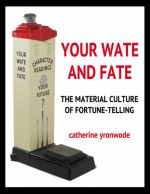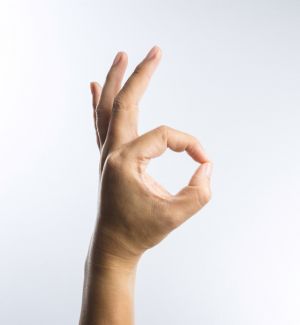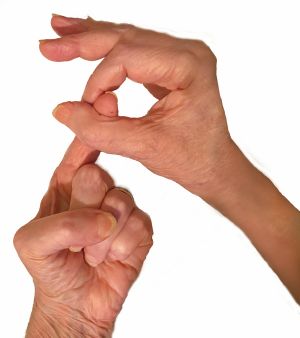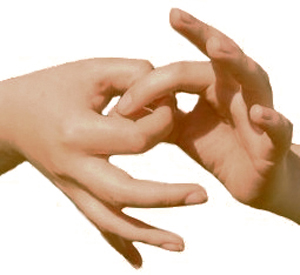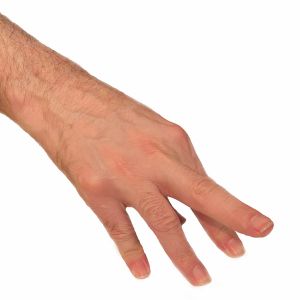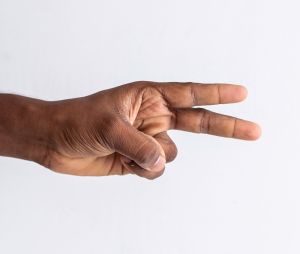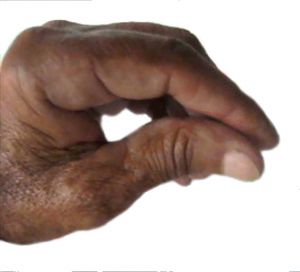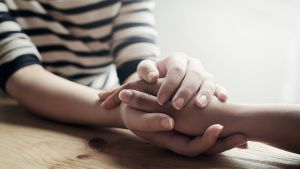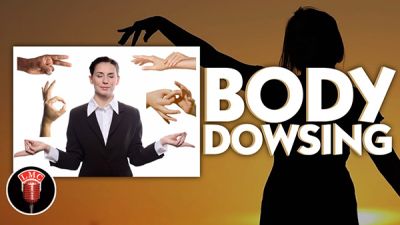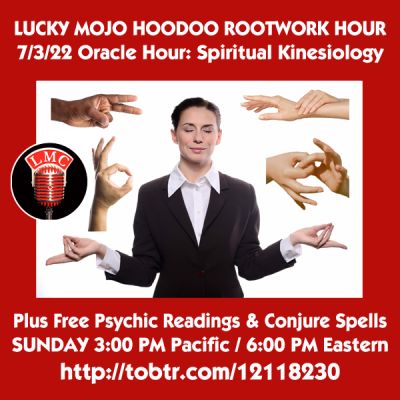Muscle Testing, Applied Kinesiology, Applied Kinesthesiology: Difference between revisions
(→Where Does the Information Come From?: grammar) |
(→A Book in the Making: caption) |
||
| (17 intermediate revisions by 2 users not shown) | |||
| Line 32: | Line 32: | ||
==Spiritual Kinesiology== | ==Spiritual Kinesiology== | ||
Divination by means of one's hands or body has been around as a folk practice for generations and so it goes under many names, including '''muscle testing, manual muscle testing, self muscle testing, manual muscle testing, kinesiology, applied kinesiology, kinesthesiology, applied kinesthesiology,''' and '''neuro-emotional technique.''' Because certain physical therapy techniques are also known as kinesiology, i have come up with a specific term for practice: '''spiritual | [[Image:Holding-a-Witness-Sample.jpg|right|300px|thumb|One way to hold a witness sample is to keep it beneath three of the fingers of the hand which you will use to perform the muscle testing. This leaves either your index finger or thumb free to perform the test on the other hand]] | ||
[[Image:Kinesiology-Hands-Holding-Space.jpg|right|thumb|300px|When weighing or swaying with a single object, it is convenient and easy to hold the witness sample in your two cupped hands at heart or waist level]] | |||
[[Image:Muscle-testing-circle.jpg|right|thumb|300px|When making a circle with your thumb and a finger for muscle testing, some people say that holding the fingers upright is a form of asking for a reply from heavenly or divine sources]] | |||
[[Image:Muscle-Testing-Little-Finger.jpg|right|300px|thumb|Trying to break a circle made with the little finger and thumb by pulling outward with the little finger of the other hand]] | |||
[[Image:Muscle-Testing-Photo-01.jpg|right|300px|thumb|Trying to break a circle made with the forefinger and thumb by pushing outward with the index finger of the other hand]] | |||
[[Image:Muscle-testing-4.jpg|right|thumb|300px|The double circles gesture]] | |||
[[Image:The-Little-Animal.jpg|right|thumb|300px|The little animal gesture]] | |||
[[Image:Pressing-Down-the-Little-Animal-with-Three-Fingers.jpg|right|300px|thumb|Trying to press down the head of the little animal with three fingers of the other hand]] | |||
[[Image:Muscle-testing-scissors.jpg|right|thumb|300px|The scissors gesture]] | |||
[[Image:Muscle-Testing-Photo-02.jpg|right|300px|thumb|Trying to close the scissors by pressing between the thumb and three fingers of the other hand]] | |||
[[Image:Kinesiology-finger-thumb-rub.jpg|right|thumb|300px|The finger-thumb rub or smooth-and-sticky gesture]] | |||
[[Image:Muscle-testing-2.jpg|right|thumb|300px|The weighing gesture with two hands for a comparison test]] | |||
[[Image:Kinesiology-swaying-back.jpg|right|thumb|300px|Swaying back from the hips or the heels signifies aversion, disbelief, or a "no" answer to a question]] | |||
[[Image:Kinesiology-swaying-forward.jpg|right|thumb|300px| Swaying forward from the hips or the heels signifies attraction, agreement, or a "Yes" answer to a question]] | |||
[[Image:Muscle-Testing-Photo-04.jpg|right|300px|thumb|One of several light grips used for self muscle testing or for Hellstromism]] | |||
[[Image:Muscle-testing-3.jpg|right|thumb|300px|Holding the hand gesture, used to read the muscles of a client or for Hellstromism]] | |||
[[Image:Empathic-hands.jpg|right|thumb|300px|Another hand-holding gesture; this one can only be used by a reader on a seated in-person client]] | |||
Divination by means of one's hands or body has been around as a folk practice for generations and so it goes under many names, including '''muscle testing, manual muscle testing, self muscle testing, manual muscle testing, kinesiology, applied kinesiology, kinesthesiology, applied kinesthesiology,''' and '''neuro-emotional technique.''' Because certain physical therapy techniques are also known as kinesiology, i have come up with a specific term for practice: '''spiritual kinesiology.''' The word "kinesiology" derives from two Greek words and means "the study of movement." To avoid confusion with certain medical physical therapy techniques centered on range-of-motion bodywork, which are also known as kinesiology, i have suggested a new name for these body-centered divinatory and healing techniques: spiritual kinesiology. | |||
==Guidance Arising From Your Own Body== | |||
Spiritual kinesiology consists of reading your own body, reading a client's body, or instructing a client to read his or her own body for answers to questions. The answers generally take the form of binary "Yes" or "No" replies, and by means ofa series of finely nuanced questions, complex queries can lead to answers. | |||
As a form of divination, muscle testing is classified broadly under the form of divination known as automatism, which also includes automatic writing with a planchette, use of the spirit board, dowsing by hand or with tools, such as rods held in the hand, and pendulum divination. However, in muscle testing, the only tool used is the body. In this regard, it is most closely related to hand dowsing, in which autonomic or ideomotor movements of the reader's hand are used as the indicator that conveys information to the reader's own eye and mind. | |||
Spiritual kinesiology is different than body reading via phrenology, aura reading, face reading, foot reading, mole reading, vulvamancy, palmistry, psychometry, graphology, or other forms of visual or tactile scanning of the client, and the difference is that it is not the result of information gathering about the client by the practitioner, but arises internally within the neuro-muscular body of the practitioner or the client. It is also different than Hypnotism in that no instructions or suggestions are given to the client, nor is the client put into a trance. | Spiritual kinesiology is different than body reading via phrenology, aura reading, face reading, foot reading, mole reading, vulvamancy, palmistry, psychometry, graphology, or other forms of visual or tactile scanning of the client, and the difference is that it is not the result of information gathering about the client by the practitioner, but arises internally within the neuro-muscular body of the practitioner or the client. It is also different than Hypnotism in that no instructions or suggestions are given to the client, nor is the client put into a trance. | ||
| Line 99: | Line 137: | ||
=== Learn how to hold a witness-sample === | === Learn how to hold a witness-sample === | ||
As with pendulum and rod dowsing, many practitioners of muscle dowsing feel that their results come more quickly or are more accurate if they use a "witness sample" in their hands. This is a sample of what you are looking for or asking about. A witness sample is not necessary if you are asking a simple "Yes" or "No" question, but it can be helpful if you are asking about an object or an activity that involves objects. | As with pendulum and rod dowsing, many practitioners of muscle dowsing feel that their results come more quickly or are more accurate if they use a "witness sample" in their hands. This is a sample of what you are looking for or asking about. A witness sample is not necessary if you are asking a simple "Yes" or "No" question, but it can be helpful if you are asking about an object or an activity that involves objects. | ||
| Line 197: | Line 201: | ||
Some people attach a meaning to whether the circle on the right hand breaks or the circle on the left hand breaks. For instance, if the circle on the non-dominant hand breaks, they may say that the answer is a "fated no," but if the circle on the dominant hand breaks, they may say it will be "a unexpected loss." | Some people attach a meaning to whether the circle on the right hand breaks or the circle on the left hand breaks. For instance, if the circle on the non-dominant hand breaks, they may say that the answer is a "fated no," but if the circle on the dominant hand breaks, they may say it will be "a unexpected loss." | ||
Remember WILL THE CIRCLE BE UNBROKEN. The strong "Yes" is indicated by two unbroken circles. A weak "No" may result in one or both circles breaking. | You can use this technique while counting -- then the circle breaks, choose the number BEFORE the break. | ||
Remember WILL THE CIRCLE BE UNBROKEN. The strong "Yes" is indicated by two unbroken circles. A weak "No" may result in one or both circles breaking. | |||
=== Finger Lift or The Little Animal=== | === Finger Lift or The Little Animal=== | ||
| Line 203: | Line 209: | ||
In a relaxed seated position, place your hand on your thigh, close to the kneecap, and raise your middle finger. You may bring your four fingers close together to make a little animal with four legs and a long proboscis, like an elephant or an anteater. | In a relaxed seated position, place your hand on your thigh, close to the kneecap, and raise your middle finger. You may bring your four fingers close together to make a little animal with four legs and a long proboscis, like an elephant or an anteater. | ||
The testing is done with from one to four fingers of the other hand trying to press down the middle finger, to make the little animal bow its head in submission. | The testing is done with from one to four fingers of the other hand trying to press down the middle finger, to make the little animal to bow its head in submission. | ||
This position can also be done with the little animal on a table rather than the knee. | This position can also be done with the little animal on a table rather than the knee. | ||
| Line 215: | Line 221: | ||
Then, with the thumb and first finger of your other hand, create a pair of pincers and try to close the scissors. You can also use the downward pressure of from one to four fingers of the other hand to try to force the scissors closed. | Then, with the thumb and first finger of your other hand, create a pair of pincers and try to close the scissors. You can also use the downward pressure of from one to four fingers of the other hand to try to force the scissors closed. | ||
Remember I SHALL NOT BE MOVED. The strong "Yes" scissors refuse to be closed, and the weak "No" scissors | Remember I SHALL NOT BE MOVED. The strong "Yes" scissors refuse to be closed, and the weak "No" scissors allow themselves to be shut. | ||
=== Finger-Thumb Rub, Smooth-and-Rough, or Smooth-and-Sticky === | === Finger-Thumb Rub, Smooth-and-Rough, or Smooth-and-Sticky === | ||
| Line 289: | Line 295: | ||
==A Book in the Making== | ==A Book in the Making== | ||
This web page originated as an outline for a radio podcast i did in 2022 for the Lucky Mojo Hoodoo Rootwork Oracle Hour with ConjureMan and Miss Maranda. | This web page originated as an outline for a radio podcast i did in 2022 for the Lucky Mojo Hoodoo Rootwork Oracle Hour with ConjureMan and Miss Maranda. | ||
It can now be found on YouTube! Go to: | |||
[[File:Spiritual-Kinesiology-Thumbnail-600.jpg|center|thumb|400px|'''https://youtu.be/_L1jbAT3qiU''' and '''https://forum.luckymojo.com/lmhrhour-chat-log-july-3-oracle-hour-muscle-testing-applied-kinesiology-t97558.html''']] | |||
'''Spiritual Kinesiology'''<br> | |||
'''Lucky Mojo Hoodoo Rootwork Hour 7/3/22'''<br> | |||
'''with co-hosts catherine yronwode and ConjureMan,'''<br> | |||
'''special guest Miss Maranda, and announcer Troll Towelhead.'''<br> | |||
'''https://youtu.be/_L1jbAT3qiU''' | |||
Co-hosts Miss Cat and ConjureMan, with special guest Miss Maranda and announcer Troll Towelhead, present a tutorial on spiritual kinesiology (also known as muscle testing, body dowsing, applied kinesthesiology, or applied kinesiology), and provide free readings, free spells, and conjure consultations, giving listeners an education in African-American folk magic. | |||
Or listen to the sound file in the audio archive: <br> | |||
'''https://tolmcrn.com/HRH650''' | |||
And you can read the chatlog for the show here: <br> | |||
'''https://forum.luckymojo.com/lmhrhour-chat-log-july-3-oracle-hour-muscle-testing-applied-kinesiology-t97558.html''' | '''https://forum.luckymojo.com/lmhrhour-chat-log-july-3-oracle-hour-muscle-testing-applied-kinesiology-t97558.html''' | ||
[[File:2022-07-03-LMHR-Oracle-Hour-Ad.jpg|center|thumb|400px|''' | [[File:2022-07-03-LMHR-Oracle-Hour-Ad.jpg|center|thumb|400px|'''https://youtu.be/_L1jbAT3qiU''' and '''https://forum.luckymojo.com/lmhrhour-chat-log-july-3-oracle-hour-muscle-testing-applied-kinesiology-t97558.html''']] | ||
| Line 306: | Line 326: | ||
I am currently writing a complete 96-page book on this subject, teaching you how to use your body as a tool to answer the questions posed by your mind. | I am currently writing a complete 96-page book on this subject, teaching you how to use your body as a tool to answer the questions posed by your mind. | ||
<i><b>catherine yronwode</b><br>curator, historian, and docent | <i><b>catherine yronwode</b><br>curator, historian, and docent | ||
| Line 319: | Line 331: | ||
(Photography by nagasiva yronwode, catherine yronwode, and unknown photographers; photo-edited by catherine yronwode and nagasiva yronwode) | (Photography by nagasiva yronwode, catherine yronwode, and unknown photographers; photo-edited by catherine yronwode and nagasiva yronwode) | ||
[[Category:Divination Methods]] | |||
Latest revision as of 00:35, 21 October 2025
In this installment of "Your Wate and Fate," we take a sneak-peek look at an upcoming page that will eventually be on display to the public. As a Patreon supporter, you have access to the page one full year before the public does.
- Patreon Release Date: July 7th, 2022.
- Public Release Date: July 7th, 2023.
Please tell your friends that they can subscribe to my Patreon stream for $2.00 per week:
To discuss this and other Your Wate and Fate pages with me, join my private Patreon Forum here:
Support Your Wate and Fate
All of the material you have access to here -- the instructive booklets, the nostalgic postcards, the boldly graphic ephemera, and all of the historical information researched and shared from the mind of the woman who is making it all happen -- can easily fit into one 8 x 10 foot room in an old Victorian farmhouse, but you would never see it without the investment of the time it takes to produce such a site and the caloric input such a site requires in the form of food for the writer, graphic designer, and database manager, as well as the US currency needed to pay for the computers, software applications, scanners, electricity, and internet connectivity that bring it out of that little room and into the world.
So, as you can see, this site is the darling of many, and it is growing at a rapid rate ... but although it is "free," there also is a cost. The financial support of my Patreon subscribers -- my Patrons -- underwrites this cost.
Please tell your friends that they can subscribe to my Patreon stream for $2.00 per week:
Patrons; To discuss this and other Patreon pages with me, join my private Patreon Forum:
Spiritual Kinesiology
Divination by means of one's hands or body has been around as a folk practice for generations and so it goes under many names, including muscle testing, manual muscle testing, self muscle testing, manual muscle testing, kinesiology, applied kinesiology, kinesthesiology, applied kinesthesiology, and neuro-emotional technique. Because certain physical therapy techniques are also known as kinesiology, i have come up with a specific term for practice: spiritual kinesiology. The word "kinesiology" derives from two Greek words and means "the study of movement." To avoid confusion with certain medical physical therapy techniques centered on range-of-motion bodywork, which are also known as kinesiology, i have suggested a new name for these body-centered divinatory and healing techniques: spiritual kinesiology.
Guidance Arising From Your Own Body
Spiritual kinesiology consists of reading your own body, reading a client's body, or instructing a client to read his or her own body for answers to questions. The answers generally take the form of binary "Yes" or "No" replies, and by means ofa series of finely nuanced questions, complex queries can lead to answers.
As a form of divination, muscle testing is classified broadly under the form of divination known as automatism, which also includes automatic writing with a planchette, use of the spirit board, dowsing by hand or with tools, such as rods held in the hand, and pendulum divination. However, in muscle testing, the only tool used is the body. In this regard, it is most closely related to hand dowsing, in which autonomic or ideomotor movements of the reader's hand are used as the indicator that conveys information to the reader's own eye and mind.
Spiritual kinesiology is different than body reading via phrenology, aura reading, face reading, foot reading, mole reading, vulvamancy, palmistry, psychometry, graphology, or other forms of visual or tactile scanning of the client, and the difference is that it is not the result of information gathering about the client by the practitioner, but arises internally within the neuro-muscular body of the practitioner or the client. It is also different than Hypnotism in that no instructions or suggestions are given to the client, nor is the client put into a trance.
Where Does the Information Come From?
Among those who use muscle testing to answer questions, several theories have arisen as to the source of the body movements. You will hear some say that the source is God or the Universe or the Divine, while others will state that the source is the practitioner's subconscious or unconscious mind, an otherwise unaccessed memory, or mental telepathy.
If a practitioner believes the source to be divine, or wishes to receive answers from the spirits of people, places, animals, plants, or any exterior source, he or she will be more inclined to ask broad questions about the future or exterior events, such as "Does [Name] love me?," "Am i going to win the lottery this year?," or "Will i ever get married?"
If the practitioner believes the source to be internal to the self or to arise from unconscious knowledge, subconscious thoughts, unaccessed memories, or mental telepathy. he or she may use muscle testing primarily to pose and answer questions about the self, such as, "Should i tell [Name] that i love him?," "Will going to London be good for me?," or "Should i see a doctor about this pain?"
Some practitioners embrace all of these theories and use different forms of muscle testing to obtain answers from the divine, from distant sources, and from their own inner selves.
How Do You Do It?
Muscle testing may be induced by asking a question or performing a routinized or ritual set of self-instructions or movement patterns to bring about the state of receptivity.
Have your question in mind before you begin.
Choose a comfortable position
Start by sitting or standing, legs and arms uncrossed. Take a few easy breaths to relax. The position need not be formal; simply sitting in a chair or standing up is sufficient.
Sitting or standing with the legs and arms uncrossed is based in the belief that one's proprioceptive sense or inner knowledge of the position of the body should be as neutral as possible, so that any changes that occur to the body during the muscle testing session will be easily perceptible.
Bless the work of your hands
Because muscle testing is often conducted through hand gestures, it is a common practice among folk practitioners who come from a Christian or Jewish background to begin by asking God to start with a hand blessing.
A refreshing scent such as a blessing oil, incense, soap, or tea made from herbs can be used to anoint your hands. This is not a cleansing; it is a blessing, so choose your herbs accordingly. Floral and citrus scents are preferable to minty or camphor scents in this application.
The blessing of the hands in Psalms 90:17 is traditional among those who practice spiritual kinesiology:
And let the beauty of the Lord our God be upon us: and establish thou the work of our hands upon us; yea, the work of our hands establish thou it.
Test Your Yes and No
In the next section, you will learn a wide variety of hand and body gestures used in performing kineasiology. After selecting any of the methods outlined below, test your "Yes" and your "No" with your name and another name.
Ask if you are your name. The response you get to your own name is "Yes," the affirmative truth.
You may find that your whole body agrees with your hands in this matter. Your lips may gently smile. You may tip your head or nod in acquiescence. You may learn forward in acceptance.
Now ask if you are another name. The response you get to the other name is "No," an untruth.
To evoke an emphatic "no" for imprinting or setting your responses, choose a name of another gender, and, better yet, the name of someone of another gender whom you really dislike and never want to see again. Your hands will react, but you may find even more than your hands telling you, "No." Your upper lip may curl into a sneer or a snarl. Your head and upper body may jerk back. This is your body telling you, "No!" Remember this sensation.
Learn the Mnemonics
When first taking up the practice of applied kinesiology, people sometimes have trouble remembering which hand position means a "Yes" and which means a "No." I use two old gospel songs as mnemonics or memory aids for most of the finger position methods. The song titles are
"I SHALL NOT BE MOVED" and "WILL THE CIRCLE BE UNBROKEN"
I shall not be moved refers to a hand gesture such as stiff scissor-fingers that will not yield to pressure. It will not be moved.
Will the circle be unbroken refers to the happily circled fingers of a "yes," which cannot be broken open by an intrusive finger or thumb. The circle is unbroken.
In addition to these, when using the Stand and Sway method, i think of the old Dean Martin song:
"SWAY WITH ME"
Sway with me signifies the loosening of the body as it moves in union with an object that is desired or useful and pulls back from an object that holds no attraction or is harmful.
Learn how to hold a witness-sample
As with pendulum and rod dowsing, many practitioners of muscle dowsing feel that their results come more quickly or are more accurate if they use a "witness sample" in their hands. This is a sample of what you are looking for or asking about. A witness sample is not necessary if you are asking a simple "Yes" or "No" question, but it can be helpful if you are asking about an object or an activity that involves objects.
For instance, if you are asking about the best date for planting beans, hold some beans in one of your hands, but if you are asking about the acquisition of money, hold a coin in one hand.
How, or if, you hold the witness sample will depend on which of the gestural methods you are using.
Weighing and swaying lend themselves most easily to holding a witness sample because both of your hands are free.
With any of the finger-and-thumb circle gestures you can hold the witness sample in the non-circling hand — the one from which you will use one or more fingers to try to break the circle. The same is true for any of the gestures that are tested by pushing two fingers together or pressing one finger down; the witness sample is most easily held in the hand that does the testing
However, if you make a circle with your index finger and thumb, you may be able to curl a witness sample in the three spare fingers of that same hand, although it may be a tight fit getting your other index finger up-and-in there to try to break the circle.
A Variety of Useful Hand and Body Gestures
Because muscle testing is generally taught person-to-person, many techniques have developed over the years, and they have been given quite a few names. Here are some of the most common methods, and a few of the names by which they are known.
Each of these methods has its own sub-variations, and, as muscle testing is usually taught by a magical coach, all of these variants are spiritually and metaphysically valid and you are free to choose whichever ones work for you and suit you best.
Be aware that some techniques will work better for you than others. This may be based on your anatomy and joint mobility rather than on any occult "meaning." Even if only one or two methods appeal to you and produce results, you are going to be a competent muscle reader who can find useful answers to questions for the rest of your life.
I should not have to explain this, but it has come up in my own learning and teaching, so i want to impress upon you that any mentor or guide who tries to dictate some sort of "one right way" to you when explaining how to perform or interpret any basic gesture of kinesiology is actually attempting to control how you relate to and experience your own body — and that, as we all know, is a form of intrusive and intolerable authoritarianism that no free person should endure.
Circle, Circuit, or Finger Lock
Make a circle with one finger and your thumb. Which finger you use to make the circuit or lock with your thumb can vary by the individual.
The little finger or Mercury finger and thumb make the weakest lock, and for this reason some people prefer it, as it seems to be easy to break, but often is not.
Some prefer the Solar ring finger and thumb to make the circle, especially choosing the wedding ring finger and thumb of the left hand when asking questions about love and marriage.
The middle or Saturn finger symbolizes duty and can be used to answer questions about job and career issues.
The first or Jupiter finger is the acquisitive finger and may be employed when asking questions about finances and investments.
However, even if you memorize those meanings to the fingers, do not be surprised if you end up having a favourite or go-to finger that you rely upon most of the time.
The orientation of the fingers and circle, whether vertical or horizontal, will also vary by individual and may also vary based on the type of information to be gathered.
Some say that upright fingers and a vertical circle indicate a question to the Divine, while pointing the fingers in a horizontal direction indicates a query and reply from that specific direction, either physical (a field to be planted, for instance) or symbolic (East for arrival, West for departure, and so forth).
Be that as it may, not everyone takes note of vertical or horizontal orientation. Many people just do what is comfortable to them at the time.
After making your finger-and-thumb circle, insert a finger or thumb of the other hand into the circle, from below, above, outside, or inside, as you choose. The finger you use can be that which feels best to you or one that has certain astrological or symbolic meanings to you.
Position the back of the finger (the nail side) -- or the front pad (the fleshy side) -- of your chosen finger or thumb against the joining-place between your circled finger and thumb and push outward with the inserted finger or thumb to try to break the circle. The index finger makes the strongest "breaker." The little finger makes the weakest "breaker."
Before choosing which finger you will use on a regular basis, try them all -- each finger and thumb, forward and backward -- to learn about the relative strengths and weaknesses of those fingers. Do not have a question in mind. Just test the options.
If you think that record-keeping may help you settle on a preferred combination of "finger circle" and "breaker finger," you can take notes on how each combination felt and refer to these later. Remember also that you can vary the "breaker" finger chosen for any given question, based on the astrological correspondences to that finger.
You may also insert the first finger and thumb, pressed together, into the circle. Then, to break the lock, just widen the space between them to test if the circle will hold or give way before their outward pressure.
Try all of these options. Be aware that you may have a favourite or "most accurate" choice for yourself, but other people may choose other fingers and finger-positions for use with the basic circle-lock gesture.
Remember WILL THE CIRCLE BE UNBROKEN. The strong "Yes" is an unbroken circle. The weak "No" allows the circle to be broken.
Double Circles or The O-Rings
In this position, the first finger and thumb of one hand link through the first finger and thumb of the other hand. Some people use this method with the little finger and thumb of each hand.
Pull the hands apart and see if one or both of the circles break apart.
Some people attach a meaning to whether the circle on the right hand breaks or the circle on the left hand breaks. For instance, if the circle on the non-dominant hand breaks, they may say that the answer is a "fated no," but if the circle on the dominant hand breaks, they may say it will be "a unexpected loss."
You can use this technique while counting -- then the circle breaks, choose the number BEFORE the break.
Remember WILL THE CIRCLE BE UNBROKEN. The strong "Yes" is indicated by two unbroken circles. A weak "No" may result in one or both circles breaking.
Finger Lift or The Little Animal
In a relaxed seated position, place your hand on your thigh, close to the kneecap, and raise your middle finger. You may bring your four fingers close together to make a little animal with four legs and a long proboscis, like an elephant or an anteater.
The testing is done with from one to four fingers of the other hand trying to press down the middle finger, to make the little animal to bow its head in submission.
This position can also be done with the little animal on a table rather than the knee.
Remember I SHALL NOT BE MOVED. The strong "Yes" refuses to lower its head; the weak "No" hangs its head in shame.
Scissors or Scissor-Fingers
With your thumb, hold down your bent little and ring fingers, and stick up your first and middle fingers, like a blessing sign, and spread your index finger and middle finger apart into a V. Now rotate your wrist so that your palm faces inward, toward your chest, and the V is horizontal, like a pair of scissors about to make a cut.
Then, with the thumb and first finger of your other hand, create a pair of pincers and try to close the scissors. You can also use the downward pressure of from one to four fingers of the other hand to try to force the scissors closed.
Remember I SHALL NOT BE MOVED. The strong "Yes" scissors refuse to be closed, and the weak "No" scissors allow themselves to be shut.
Finger-Thumb Rub, Smooth-and-Rough, or Smooth-and-Sticky
Lightly rest your index finger on your thumb and move it back and forth or around in a small circle or oval. The movement should be smooth and easy. Now test your "Yes" and your "No." If you are like most people, during your "Yes" the movement is slow and gliding, but on your "No," the finger and thumb will stick or move jerkily.
If your fingers are wet, this method will not work, and it also is not useful for those who have chronically sweaty skin. However, it is the most stealthy method of muscle testing you can use, because it is accomplished single-handedly, and can be done from a sitting or standing position, out of sight of anyone around you. For this reason it is employed when talking to a person and trying to ascertain whether he or she is being truthful or can be trusted.
Remember SMOOTH OR STICKY. The gently gliding motion means a smooth and open road, and the stuck or jerky motion means a bumpy road ahead.
Hands Up or Weighing
This method can be used to spiritually weigh one object against another, if a choice is to be made between them. You may close your eyes when weighing, and many people do so. It is customary to put a witness sample into each hand if choosing between two objects.
If weighing and counting one object -- how many copies of the object to buy or how much money to pay -- you need only one object and may use just the one hand.
Some people extend their arms all the way outward, palms up and holding the witness samples, but most people relax and bend their elbows downward or even rest the elbows atop their hips. Some people brace their elbows on their hips and hold their hands upward and forward rather than out at an angle.
The two-handed weighing method is best used for comparing objects, such as foods to eat, medicines or supplements to take, or items to be purchased.
The single-handed weighing method can be used to determine the price you wish to pay for an object, by calling out the prices (silently or aloud) until a response is made, or how many of the item you wish to purchase. Count slowly and watch your hand move. It it stays high, you are in "Yes" territory. If it begins to sink, you are reaching the "No" point.
Remember I SHALL NOT BE MOVED. The hand that stays in place is a strong "Yes." The hand that sinks beneath the weight is fading away to "No."
Stand and Sway, Swing and Sway, or Sway With Me
With this method you become a human pendulum. Stand up with your arms at your sides. Sway forward and back a few times to loosen yourself up and get a sense of your range of motion while remaining balanced. Then test yourself with your name and another name and you will probably find that you sway forward with attraction for "Yes" and backward with aversion for "No."
However, as with a suspended pendulum, your personal method of swaying may vary from the average response. For example, some people naturally sway from front to back for "Yes" and side to side for "No," and others sway side-to-side for "Yes," and front-to-back for "No."
For this reason, the sway method is the most variable of them all, and you may wish to test it with some known attractive and repellant foods, to understand your body better -- or you may choose to train your responses, in the same way that a pendulum is trained, so that your body responds to the instructions you have given it.
If you are going to use a witness sample while swaying, the most common position is to hold it in both hands, centered at heart or wist level. Closing the eyes is common among those who do the sway.
Remember SWAY WITH ME. For most people, the strong "Yes" sways closer to the desired item, and the weak "No" rocks back on its heels.
Holding Your Own Hand
Use your non-dominant hand to lightly hold the arm, wrist, or fingers of your dominant hand. There are many positions of hand-holding possible, from the old "testing the pulse" grip to cupping the fingers in the other hand, as if warming them up.
The hand being held functions as a pendulum or pointer. It may relax and go limp or it may spontaneously point the way to a certain physical direction. Do not force it; simply interpret the movements.
Remember I SHALL NOT BE MOVED. For many people, a firm wrist indicates a "Yes" and a weakly drooping wrist signifies resignation or lack of energy, a sort of acquiescent "No."
Muscle Reading, Hellstromism, Contact Mind Reading
Among psychic readers who use muscle testing in person for their clients, there is one gestural position that has found almost universal favour. It is similar to the "Holding Your Own Hand" position, but in this case it is the reader who touches or holds the fingers, hand, wrist, arm, or shoulder of the client and perceives the subtle, unconscious movements of the client's hand, arm, or shoulder to gain information about the client's concerns or subconscious knowledge.
This method is called muscle reading, Hellstromism, or contact mind reading. The name Hellstromism derives from the German muscle reader Axel Hellstrom (1893 – 1933), who wrote an explanatory book on the subject and toured America demonstrating his ability to read the involuntary movements of a subject's muscles.
The difference between muscle testing and muscle reading is that in muscle testing, the individual receives direct replies to his or her own questions, while in muscle reading, the practitioner reads the thoughts of a subject by interpreting small, almost imperceptible movements of the subject's muscles.
Suffice it to say that muscle reading is a lot more difficult to do than muscle testing, but it can -- and has -- been done successfully for well over a hundred years.
If you want to learn, the best way is to practice on a child. Your own young children will make the best subjects because they trust you and are not inclined to try to conceal their thoughts from you.
Ask the child to hide an object in a room while you step outside. Enter the room when the child says, "Ready," and take the child's wrist in hand. Tell the child to not show you where the object is or point to it, or say a word about it, or guide you to it in any way. Start to walk, very slowly, in any direction, with your hand around the child's wrist. You will sense resistance or acquiescence. Keep repositioning and walking until, as if by magic, the child will subconsciously "allow" you to reach the hidden object without a word being spoken.
It is my experience that when acting as the guide in this kind of experiment, some children slip into a light trance. Upon finding the hidden object, be sure that the child is fully aware, and give a smile, a hug, and a reward.
Then, if you are courageous, change places. You hide the object and see if the child can read your muscles and find the hidden item. You may be surprised. Some children are better at Hellstromism than their parents are!
Distance Reading by Applied Kinesiology
While the various finger gestures and the full body sway are designed for self-use, a trained psychic reader can easily employ these methods to answer questions for a client at long distance.
Most readers ask for or create a witness sample to represent the client or the one about whom the questions will be asked. A name paper, photo, or tarot card symbolizing the querent or the subject of the reading is usually sufficient. Hold the witness sample in the hand that will try to break the circle, close the scissors, or lower the little animal's head.
I find it most convenient when doing this to curl the witness sample under the middle, ring, and little finger on my non-dominant hand, and hold them in place with my thumb. This frees my non-dominant index finger to attempt to move the position i have established my dominant hand.
If i have no witness sample readily to hand, i may select a tarot card to represent the person about whom or for whom the query is being made. I use the old court-card significator method for this: Pentacles are earth signs, Swords are air signs, Wands are fire signs, and Cups are water signs. Young people are Knights (male) or Pages (female), while mature people are Kings (male) or Queens (female). Little though i am, my hands are flexible enough that i can insert a Rider-Waite-Smith mini-tarot card sideways in my left palm and conceal it from view.
A Book in the Making
This web page originated as an outline for a radio podcast i did in 2022 for the Lucky Mojo Hoodoo Rootwork Oracle Hour with ConjureMan and Miss Maranda.
It can now be found on YouTube! Go to:
Spiritual Kinesiology
Lucky Mojo Hoodoo Rootwork Hour 7/3/22
with co-hosts catherine yronwode and ConjureMan,
special guest Miss Maranda, and announcer Troll Towelhead.
https://youtu.be/_L1jbAT3qiU
Co-hosts Miss Cat and ConjureMan, with special guest Miss Maranda and announcer Troll Towelhead, present a tutorial on spiritual kinesiology (also known as muscle testing, body dowsing, applied kinesthesiology, or applied kinesiology), and provide free readings, free spells, and conjure consultations, giving listeners an education in African-American folk magic.
Or listen to the sound file in the audio archive:
https://tolmcrn.com/HRH650
And you can read the chatlog for the show here:
https://forum.luckymojo.com/lmhrhour-chat-log-july-3-oracle-hour-muscle-testing-applied-kinesiology-t97558.html
In 2023, after this Patreon-supported web page was released to the public, i donated a very abbreviated version of the text to the Association of Independent Spiritual Churches for use on their educational Association of Independent Readers and Rootworkers website, here:
https://www.readersandrootworkers.org/wiki/Category:Muscle_Testing_and_Spiritual_Kinesiology
I am currently writing a complete 96-page book on this subject, teaching you how to use your body as a tool to answer the questions posed by your mind.
catherine yronwode
curator, historian, and docent
Your Wate and Fate
(Photography by nagasiva yronwode, catherine yronwode, and unknown photographers; photo-edited by catherine yronwode and nagasiva yronwode)
